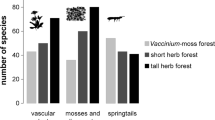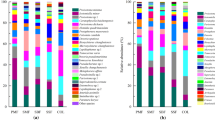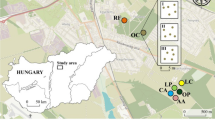Abstract
• Context
In July 2005, a wildfire occurred in windthrown spruce forests in High Tatra Mountains and damaged roughly 229 ha of previously clear-cut area.
• Aims
The present study focuses on assessing the influence of fire disturbance upon collembolan communities and compares the subsequent development of the model communities at burnt and unburnt stands 2 years after fire disturbance.
• Methods
Three different treatments were selected for the study: REF stands—intact forest stands; EXT stands—clear-cut windthrown stands; and FIR stands—clear-cut windthrown stands subsequently damaged by wildfire. The study of soil microarthropods was carried out in three stands of each treatment, from soil samples taken in April and September of 2007. For statistical evaluation of results repeated measure analysis of variance and cluster analysis with indicator values were used.
• Results
Total material comprised of 3,632 specimens with 56 collembolan species identified. The highest Collembola abundance means were recorded in FIR stands, with the same parameter being significantly lower in REF and EXT stands. The mathematical methods demonstrated clear differences in the collembolan communities between the different treatments studied.
• Conclusion
The present study showed that natural wildfire may increase abundance and species richness of soil Collembola in mountain spruce forests previously damaged by windthrow.

Similar content being viewed by others
References
Bretfeld G (1999) Symphypleona. In: Dunger W (ed) Synopses on palaearctic Collembola, vol. 2. Abhandlungen und Berichte des Naturkundemuseums, Görlitz, 318 p
Certini G (2005) Effects of fire on properties of forest soils: a review. Oecologia 143:1–10
Čerevková A, Renčo M (2009) Soil nematode community changes associated with windfall and wildfire in forest soil at the High Tatras National Park, Slovak Republic. Helminthologia 46:123–130
Coleman TW, Rieske LK (2006) Arthropod response to prescription burning at the soil–litter interface in oak-pine forests. For Ecol Manag 233:52–60
Crossley DA, Blair JM (1991) A high efficiency, “low-technology” Tullgren-type extractor for soil microarthropods. Agric Ecosyst Environ 34:187–192
Čuchta P, Kováč Ľ, Miklisová D (2009) The effect of windthrow in the spruce forests of the High Tatras (Slovakia) on soil microarthropods one year after a severe wind calamity with special reference to Collembola (Hexapoda). In: Tajovský K, Schlaghamerský J, Pižl V (eds) Contributions to soil zoology in Central Europe III. ISB AC CR, v.v.i., České Budějovice, pp 13–18
Dress WJ, Boerner REJ (2004) Patterns of microarthropod abundance in oak-hickory forest ecosystems in realtion to prescribed fire and landscape position. Pedobiologia 48:1–8
Dufréne M, Legendre P (1997) Species assemblages and indicator species: the need for a flexible asymmetrical approach. Ecol Monogr 67:345–366
Falťan V, Bánovský M, Jančuška D, Saksa M (2008) Zmeny krajinnej pokrývky úpätia Vysokých Tatier po veternej kalamite. Geo-grafika, Bratislava, 96 p (in Slovak)
Fjellberg A (1998) The Collembola of Fennoscandia and Denmark, part I: Poduromorpha. In: Kristensen NP, Michelsen V (eds) Fauna Entomologica Scandinavica, vol. 35, Brill, 184 p
FORTRAN (2004) IndVal or how to identify indicator species of a sample typology? http://old.biodiversite.wallonie.be/outils/indval/
Geissen V, Illmann J, Flohr A, Kahrer R, Brummer GW (1997) Effects of liming and fertilization on Collembola in forest soils in relation to soil chemical parameters. Pedobiologia 41:194–201
Gömöryová E, Střelcová K, Škvarenina J, Bebej J, Gömöry D (2008) The impact of windthrow and fire disturbances on selected soil properties in the Tatra National Park. Soil Water Research 3:74–80
Haimi J, Fritze H, Moilanen P (2000) Responses of soil decomposer animals to wood–ash fertilisation and burning in a coniferous forest stand. For Ecol Manag 129:53–61
Henig-Sever N, Poliakov D, Broza M (2001) A novel method for estimation of wild fire intensity based on ash pH and soil microarthropod community. Pedobiologia 45:98–106
Johnstone JF, Stuart Chapin F III (2006) Effects of soil burn severity on post-fire tree recruitment in boreal forest. Ecosystems 9:14–31
Kim JW, Jung C (2008) Abundance of soil microarthropods associated with forest fire severity in Samcheok, Korea. Journal of Asia-Pacific Entomology 11:77–81
Králová M, Dražďák K, Pospíšil F, Hadačová V, Klozová E, Luštinec J, Kutáček M, Sahulka J (1991) Vybrané metody chemické analýzy půd a rostlin. Academia, Praha, 160 p (in Czech)
Kubíková J (1970) Geobotanické praktikum. UK, Praha, 186 p (in Czech)
Kunca A, Zúbrik M (2006) Vetrová kalamita z 19. novembra 2004. Národné lesnícke centrum, Zvolen, 40 p (in Slovak)
Kutiel P, Naveh Z (1987) The effect of fire on nutrients in a pine forest soil. Plant Soil 104:269–274
Mabuhay JA, Nakagoshi N, Isagi Y (2006) Soil microbial biomass, abundance and diversity in a Japanesse red pine forest: first year after fire. J For Res 11:165–173
Malmström A (2008) Temperature tolerance in soil microarthropods: simulation of forest-fire heating in the laboratory. Pedobiologia 51:419–426
Malmström A, Perrson T, Ahlström K, Gongalsky KB, Bengtsson J (2009) Dynamics of soil meso- and macrofauna during a 5-year period after clear-cut burning in a boreal forest. Applied Soil Ecology 43:61–74
Murphy J, Riley JP (1962) A modified single solution method for the determination of phosphate in natural waters. Anal Chim Acta 27:31–36
Nedoma J (1990) Práce s iontově selektivními elektrodami. Rostlinná výroba 36:667–670 (in Czech)
Pomorski RJ (1998) Onychiurinae of Poland (Collembola: Onychiuridae). BS, Wrocław, 201 p
Ponge J-F (2003) Humus forms in terrestrial ecosystems: a framework to biodiversity. Soil Biology Biochemistry 35:935–945
Potapov MB (2001) Isotomidae. In: Dunger W (ed) Synopses on palaearctic Collembola, vol. 3. Abhandlungen und Berichte des Naturkundemuseums, Görlitz, 603 p
Rusek J, Brůhová J (2007) Impact of bark beetle outbreak on epigeic communities of Collembola (Insecta: Entognatha) in climax spruce forests in the Šumava National Park, Czech Republic. In: Tajovský K, Schlaghamerský J, Pižl V (eds) Contributions to soil zoology in Central Europe III. ISB AC CR, v.v.i., České Budějovice, pp 121–126
Sileshi G, Mafongoya PL (2006) The short-term impact of forest fire on soil invertebrates in the miombo. Biodivers Conserv 15:3153–3160
Sommers LE, Nelson DW (1972) Determination of total phosphorus in soils: a rapid perchloric acid digestion procedure. Proceedings-Soil Science Society of America 36:902–904
StatSoft, Inc. (2009) STATISTICA (data analysis software system), version 9.0. www.statsoft.com
Tahovská K, Kopáček J, Šantrůčková H (2010) Nitrogen availability in Norway spruce forest floor—the effect of forest defoliation induced by bark beetle infestation. Boreal Environmental Research: 15:553–564
Thibaud J-M, Schulz H-J, da Gama Assalino MM (2004) Hypogastruridae. In: Dunger W (ed) Synopses on palaearctic Collembola, vol. 4. Abhandlungen und Berichte des Naturkundemuseums, Görlitz, 287 p
Watanabe FS, Olsen SR (1965) Test of ascorbic acid method for determining phosphates in water and sodium bicarbonate extracts from soils. Proceedings-Soil Science Society of America 29:677–680
Wermelinger B, Duelli P, Obrist MK (2003) Windthrow stimulates arthropod diversity in forests. Proceedings of the International Symposium, May 29–31, 2003, Mantova, pp 79–82
Wikars L-O, Schimmel J (2001) Immediate effects of fire-severity on soil invertebrates in cut and uncut pine forests. For Ecol Manag 141:189–200
Zimdars B, Dunger W (1994) Tullbergiinae. In: Dunger W (ed) Synopses on palaearctic Collembola, vol. 1. Abhandlungen und Berichte des Naturkundemuseums, Görlitz, 71 p
Acknowledgements
The study was supported from the Slovak Scientific Grant Agency VEGA project no. 1/0019/08. The authors are very grateful to Dr. Karel Tajovský and prof. Dr. H. Šantrůčková (České Budějovice, Czech Republic) for their kind help with the soil–chemical analyses. Dr. Kieran Green (UK) is acknowledged for comments and linguistic correction of the manucript.
Author information
Authors and Affiliations
Corresponding author
Additional information
Handling Editor: François Lieutier
Appendix
Appendix
Rights and permissions
About this article
Cite this article
Čuchta, P., Miklisová, D. & Kováč, Ľ. Changes within collembolan communities in windthrown European montane spruce forests 2 years after disturbance by fire. Annals of Forest Science 69, 81–92 (2012). https://doi.org/10.1007/s13595-011-0114-y
Received:
Accepted:
Published:
Issue Date:
DOI: https://doi.org/10.1007/s13595-011-0114-y




